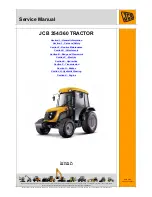
3
GENERAL OPERATION
• Read, understand, and follow all instructions in the manual and on
the unit before starting.
• Only allow responsible adults, who are familiar with the instruc-
tions, to operate the unit (local regulations can restrict operator
age).
• Clear the area of objects such as rocks, toys, wire, etc., which
could be picked up and thrown by the blade(s).
• Be sure the area is clear of other people before mowing. Stop unit
if anyone enters the area.
• Never carry passengers.
• Do not mow in reverse unless absolutely necessary. Always look
down and behind before and while travelling in reverse.
• Be aware of the mower discharge direction and do not point it at
anyone. Do not operate the mower without either the entire grass
catcher or the deflector in place.
• Slow down before turning.
• Never leave a running unit unattended. Always disengage the
PTO, set parking brake, stop engine, and remove keys before dis-
mounting.
• Turn off the PTO switch to disengage the blades when not mowing.
• Stop engine before removing grass catcher or unclogging chute.
• Mow only in daylight or good artificial light.
• Do not operate the unit while under the influence of alcohol or
drugs.
• Watch for traffic when operating near or crossing roadways.
• Use extra care when loading or unloading the unit into a trailer or
truck.
• Data indicates that operators, age 60 years and above, are
involved in a large percentage of riding mower-related injuries.
These operators should evaluate their ability to operate the riding
mower safely enough to protect themselves and others from injury.
• Keep in mind the operator is responsible for accidents occurring to
other people or property.
• All drivers should seek and obtain professional and practical
instruction.
• Always wear substantial footwear and trousers. Never operate
when barefoot or wearing sandals.
• Before using, always visually check that the blades and blade hard-
ware are present, in-tact, and secure. Replace worn or damaged
parts.
• Never operate the machine with defective guards, or without safety
protective devises in place.
• Disengage attachments before: refuelling, removing an attachment,
making adjustments (unless the adjustment can be made from the
operator’s position).
• When the machine is parked, stored, or left unattended, lower the
cutting means unless a positive mechanical lock is used.
• Follow the manufacturer’s recommendation for wheel weights or
counterweights.
SLOPE OPERATION
Slopes are a major factor related to loss-of-control and tip-over accidents,
which can result in severe injury or death. All slopes require extra caution.
If you cannot back up the slope or if you feel uneasy on it, do not operate
on it.
Control of a ride-on machine sliding on a slope will not be regained by the
application of the brake. The main reasons for loss of control are: insuffi-
cient tire grip on the ground, speed too fast, inadequate braking, the type
of machine is unsuitable for it’s task, lack of awareness of the ground con-
ditions, incorrect hitching and load distribution.
Read these safety rules and follow them closely. Failure to obey these rules could result in loss of control
of unit, severe personal injury or death to you, or bystanders, or damage to property or equipment.
This mowing deck is capable of amputating hands and feet and throwing objects.
The triangle in text signifies important cautions or warnings which must be followed.
Safety Rules & Information
WARNING
Never operate on slopes greater than 17.6 percent
(10°) which is a rise of 3-1/2 feet (106 cm) vertically in
20 feet (607 cm) horizontally.
When operating on slopes use additional wheel
weights or counterweights. See your dealer to
determine which weights are available and
appropriate for your unit.
Select slow ground speed before driving onto slope.
In addition to front and rear weights, use extra caution
when operating on slopes with rear-mounted grass
catcher.
Mow UP and DOWN the slope, never across the
face, use caution when changing directions and DO
NOT START OR STOP ON SLOPE.
Do
• See your authorized dealer for recommendations of wheel weights
or counterweights to improve stability.
• Mow up and down slopes, not across.
• Remove obstacles such as rocks, tree limbs, etc.
• Watch for holes, ruts, or bumps. Uneven terrain could overturn the
unit. Tall grass can hide obstacles.
• Use slow speed. Tires may lose traction on slopes even through
the brakes are functioning properly. Choose a low gear so that you
will not have to stop or shift while on the slope.
• Use extra care with grass catchers or other attachments. These
can change the stability of the unit.
• Keep all movement on the slopes slow and gradual. Do not make
sudden changes in speed or direction.
• Always keep unit in gear especially when traveling downhill. When
clutching, release clutch slowly.
Do Not
• Do not start or stop on a slope. If tires lose traction, disengage the
blade(s) and proceed slowly straight down the slope.
• Do not turn on slopes unless necessary, and then, turn slowly and
gradually downhill, if possible.
• Do not mow near drop-offs, ditches, or embankments. The mower
could suddenly turn over if a wheel is over the edge of a cliff or
ditch, or if an edge caves in.
• Do not mow on wet grass. Reduced traction could cause sliding.
• Do not try to stabilize the unit by putting your foot on the ground.
• Do not use grass catchers on steep slopes.
• Do not mow slopes you cannot back up.
• Do not shift to neutral and coast down hill.






































